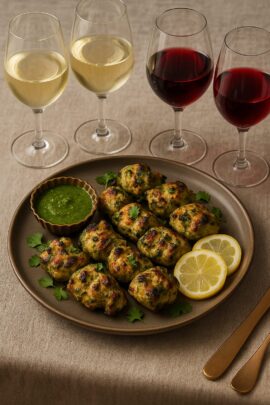1. Introduction
Dish Name & Cultural Context
Tengdi Kabab, also known as Tangdi Kabab, is a popular North Indian dish featuring marinated chicken drumsticks grilled or baked to smoky perfection. Originating from Mughlai cuisine, these kababs have long been a favorite in Indian street food and festive menus. “Tangdi” translates to drumstick, and the dish represents a convergence of aromatic spices, creamy marinades, and char-grilled textures—blending royal heritage with everyday indulgence.
Key Ingredients & Preparation Style
Tangdi Kabab is prepared by marinating chicken legs in a mixture of yogurt, ginger-garlic paste, garam masala, lemon juice, and sometimes cream or cheese. The marinade often includes green chili, coriander, cumin, and kasuri methi (dried fenugreek). The kababs are grilled until slightly charred, locking in juices and enhancing the smokiness.
Flavor & Texture Profile
- Primary Flavors: Creamy, spicy, tangy, smoky
- Texture: Juicy interior with crisp, charred edges
- Mouthfeel: Rich and velvety from dairy-based marinades, with bright acidic notes from lemon and spice
Science Behind Spice & Wine Interactions
Spice can amplify alcohol and tannins in wine, making them feel hotter or more astringent. Acidic and off-dry wines tend to cool the palate, balancing heat. Creamy textures call for medium- to full-bodied whites or soft reds with low tannin and juicy fruit.
- Capsaicin (from chili): Intensifies alcohol burn
- Acidity from lemon: Can make flabby wines seem dull
- Yogurt/cream: Requires wines with bright acidity to refresh the palate
2. Ideal Wine Pairings: Science & Art of Selection
White Wines
Gewürztraminer (Alsace, France)
- Why it Works: Aromatic and slightly off-dry, Gewürztraminer tames spice and echoes the floral, herbal character of fenugreek and coriander.
- Regions/Producers to Try:
- Trimbach, Alsace
- Zind-Humbrecht, Alsace
- Hugel et Fils, Alsace
Chenin Blanc (South Africa)
- Why it Works: Crisp acidity with tropical fruit notes cuts through creamy marinade, and slight sweetness balances spice.
- Regions/Producers to Try:
- Mullineux Family Wines, Swartland
- Ken Forrester, Stellenbosch
Furmint (Tokaj, Hungary)
- Why it Works: Dry Furmint offers racy acidity, smoky minerality, and citrusy brightness—perfect for lifting creamy, charred kababs. The volcanic soils of Tokaj add a savory, almost umami-like note that resonates with grilled meat.
- Regions/Producers to Try:
- Barta Winery, Tokaj
- Disznókő, Tokaj
- Oremus, Tokaj
Red Wines
Gamay (Beaujolais, France)
- Why it Works: Low tannins, bright red fruit, and a touch of spice complement the smokiness without amplifying heat.
- Regions/Producers to Try:
- Jean Foillard, Morgon
- Château Thivin, Côte de Brouilly
Zweigelt (Austria)
- Why it Works: Juicy, peppery, and vibrant—Zweigelt brings subtle spice and acidity to match smoky and tangy notes.
- Regions/Producers to Try:
- Heidi Schröck, Burgenland
- Stroblhof, Südtirol
Kadarka (Hungary/Bulgaria)
- Why it Works: Light-bodied but spicy, Kadarka has red currant and cherry notes with earthy, peppery edges—ideal with garam masala and grilled chicken. Its soft tannins and bright acidity make it a sleeper hit with Indian food.
- Regions/Producers to Try:
- Frittmann, Kunság (Hungary)
- Endrikat Winery, Szekszárd (Hungary)
- Bessa Valley Winery, Bulgaria
3. Unexpected Pairings: Lesser-Known but Great Choices
Sparkling Rosé (Cava or Crémant)
- Why it Works: Bubbles refresh the palate between spicy, creamy bites. Berry notes highlight charred chicken skin.
Orange Wines (Georgia or Friuli)
- Why it Works: The tannic structure from skin contact handles the grilled meat, while savory notes mirror spice complexity.
4. Wines to Avoid & Common Mistakes
- Big, oaky Chardonnays: Overpower the yogurt-based marinade and clash with acidity.
- Cabernet Sauvignon: High tannins and alcohol clash with spice and yogurt.
- Sweet dessert wines: Too cloying against savory-spicy profile.
Quick-Reference Table
| Mismatched Pairing | Why It Doesn’t Work | Better Alternative |
|---|---|---|
| Napa Cabernet Sauvignon | High tannin + high alcohol exaggerate spice | Gamay or Zweigelt |
| Oaked California Chardonnay | Heavy oak overwhelms delicate spice notes | Chenin Blanc (South Africa) |
| Dry Sherry (Fino) | Too salty and nutty for creamy texture | Sparkling Rosé or Gewürztraminer |
5. Final Thoughts & Expert Tips
Key Takeaways:
- Pair wines with low tannins and good acidity.
- Off-dry whites or light reds are best.
- Bubbles are always a clever choice for rich, spiced dishes.
Fun Fact: In traditional Indian weddings, Tangdi Kababs are often served as appetizers with soda-based mocktails. But swap that fizzy drink for a crisp sparkling rosé, and you’ll elevate the experience exponentially.
Personal Tip: I once paired a spiced but mildly hot version of Tengdi Kabab with a chilled Gewürztraminer from Pfalz, and the lychee note mirrored beautifully with fenugreek and coriander. It turned a backyard barbecue into a dinner party.
6. Recipe & Wine-Friendly Adjustments
Ingredients
- 6 chicken drumsticks
- 1 cup plain yogurt
- 1 tbsp lemon juice
- 1 tsp ginger-garlic paste
- ½ tsp chili powder
- ½ tsp garam masala
- 1 tsp kasuri methi (dried fenugreek)
- Salt to taste
- 2 tbsp cream (optional)
- 1 tbsp oil
Preparation
- Clean drumsticks, make small cuts for better marinade penetration.
- Mix all marinade ingredients in a bowl. Add chicken and coat thoroughly.
- Marinate for 4–6 hours, ideally overnight.
- Preheat grill/oven to 400°F (200°C).
- Cook for 25–30 minutes, turning halfway, until slightly charred.
- Brush with butter or cream for added richness (optional).
Wine-Friendly Modifications
- Use mild chili powder or reduce green chilies if serving with a delicate wine.
- Add a touch more lemon juice to brighten up and balance rich wines.
Serving Suggestions
- Garnish with chopped cilantro and onion rings.
- Pair with mint chutney and naan or saffron rice.
- Serve wine slightly chilled: whites at 50°F (10°C), reds around 60°F (16°C).

